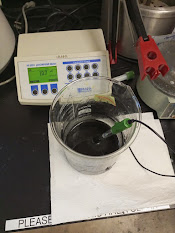See What I Found After Oven-Drying
I had informed in my previous post that I would unveil to you what I am up to, this semester. I had also told you that I would tell about what I am working on, in conjunction with my mentor, who is also my senior colleague.
To begin, Sis. Beatrice works on biochar-supported phosphate as fertilizer, where in she added some amount of anhydrous magnesium sulfate as well as potassium dihydrogen phosphate. I am doing something similar too.
The difference is the compound(s) that serve(s) as the activating ingredient. Rice husk is a biomass feedstock with high surface area, and this characteristic per se makes it a good agent for biochar use.
I took some grams of rice husk biochar dissolved in de-ionized water, activated with calcium chloride and potassium dihydrogen phosphate with some stirring at temperature 35-40 deg. C, for a period of 30 mins for each of the activators. The significance of activating with compounds as calcium chloride or magnesium sulfate is to increase the porosity of the biochar. When the porosity of biochar is high, it suitably serves as a sink and/or sponge for environmental contaminants, as well as water.
In the middle of doing this, it occurred to me that I could activate with steam too, at a temperature within 500-550 deg. C, which I did. Then I added the phosphate compound.
When you add steam to biochar, it distorts its surface, and hydrogen and carbon (II) oxide gases are liberated.
I perceive for sure, that there shall be some differences in the porosity and complexation of the two biochar samples.
Yesterday, I oven dried them, and my hypothesis is on the verge of becoming a theory. The picture below tells the difference.
 |
| Sample A: Calcium Chloride Activated vs Sample B; Steam Activated |
In summary, this semester I am working on the synthesis and characterization of untreated and activated rice husk biochar, and its application in soil amendment. By soil amendment, I will be using the biochar to immobilize some more toxic heavy metals in soil, and then applying the biochar as a source of fertilizer in infertile soils. I want to know, even though biochar is able to adsorb the heavy metal, how much of it, and how much of it serves as uptake for plants.
I shall be using at least ten (10) instruments for this work. I will be trained in the coming week. Yes, I am an analytical chemist, and I am getting proud of that.
This work is a 60-day project by estimation, although I am looking at how to use the same biochar as a supercapacitor for energy application. Is it possible? Yes, I will tell you why, but perhaps, much later. I have my leftover food in front of me, and I wanna finish it all.
I hope you were able to note one or two things in this post. If you did, please do comment about it in the comment section below, so I would know what helps and maybe, what is not clear.





Great job mentor.
ReplyDeleteThanks!
DeleteGood job 👍
ReplyDeleteThanks!
Delete